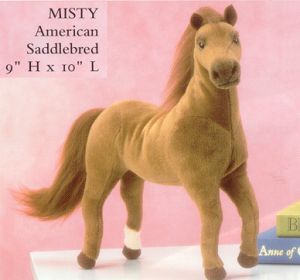|
|
The Riding Tree: Influencing the Horse
by Faith Meredith
Director, Meredith Manor International Equestrian Centre
Only when riders progress to the top of the riding tree are they
finally capable of influencing a horse to teach it something new.
Or, to remind it about something it already knows. Their
communication is clear enough and accurate enough that they can
use the language of aids pressures to show the horse new shapes.
They have developed an independent seat and muscle memory of the
correct aids. They have developed a sense of timing. They have
independent control of each body part so they can apply any aid
with varying degrees of pressure. As the horse moves underneath
them, they relax and follow its motion in perfect balance.
When we train horses, the first step is showing them what we want
them to do. Then we can ask them to do what weíve shown them.
Once they fully understand what we are asking, we can tell them
to do it. If we know they understand what we are telling them but
they refuse to do it, we can enforce our request.
Beginning riders can only ask their horses for shapes and
movements because they lack the necessary skills to demand more.
At this stage, many instructors use forgiving Goldie Oldies to
help riders learn to relax, find their balance, and learn to
follow the horseís motion. As they progress up the riding tree
and learn to both apply and coordinate their aids, riders can
begin telling their horses what to do. By interpreting the
horseís response, they can continue improving their coordination
skills. By riding many different kinds of horses, they deepen
their skills. At the lower levels on the riding tree, their
horses are their teachers.
When riders become very good at coordinating the aids, they
become capable of influencing the horse. Now they can show a baby
green horse what to do or enforcing the requests made of a
spoiled horse to retrain it. They have the necessary skills to
use artificial aids like a whip or spurs to reinforce their
requests without ruining their communication with the horse. The
riders have now become capable of teaching.
The reason the combination of a green horse and green rider is so
disastrous is that neither one is capable of teaching the other.
Neither one can give the other the necessary feedback so that
learning can take place. Similarly, until a rider is quite far
along on the riding tree, he or she lacks the necessary skills to
enforce a request when a horse deliberately refuses to respond. A
lot of school horses who know the game cheerfully choose to
ignore beginning riders. So fairly early on we do allow students
to carry crops to reinforce their leg aids. However, no one wears
spurs until they have an independent seat and time their use
correctly.
Riders must be able to ride stride by stride and influence the
horse with precise timing and degrees of their aids before they
can create something new or enforce something the horse already
knows. The difference between coordinating the aids and
influencing the horse is very subtle. It involves control of the
riderís and the horseís emotions as well as their bodies.
The ability to interpret and judge the horseís feedback becomes
very important at this stage because it determines the ridersí
responses. They must be sure they coordinated their aids
correctly and precisely. They must judge whether the horse simply
didnít understand the aids. Or they must judge that the horse
understood the aids but choose not to respond correctly. Since,
in the latter case, the timing of any enforcement is critical for
successful communication and correction of the problem, riders at
this level need to make their judgments in a split second without
any emotional involvement. The horse must feel that their
response is horse logical and fair.
Making these judgments takes experience riding many different
kinds of horses. Itís not possible for anyone to judge correctly
all of the time no matter how far they go in their riding. When
you know that a horse understands something and is choosing not
to do it, there is always the possibility that something is
physically wrong. New tack may be bothering him. He may have sore
muscles for a workout the day before. He may have caught a virus
at a show the weekend before. Instead of enforcing his or her
request, the rider may have to reevaluate the training plan for
that day and give the horse an easy workout or even a complete
rest.
When riders become trainers, they are going to be evaluating
their horses every day. When they work with a horse every day for
months they get to know its personality, its little nuances, and
it becomes easier to judge whether the horseís refusal to listen
to the aids stems from soreness or stubbornness or mental
burnout. If a horse that normally goes along with everything
suddenly turns surly, itís also OK to say letís just go out and
play on the trails. Give the horse a day off and see what
happens. All of that is a judgment call on the trainerís part.
Sometimes it seems like itís going to take a long time before a
rider reaches the point when they can influence a horse or
enforce their requests. Donít get discouraged. Remember that
youíre going to reach different levels on the riding tree on some
horses at some gaits at least some of the time before you
experience it on all horses at all gaits all of the time. Just
keep riding.
© 2001-2004 Meredith Manor International Equestrian Centre.
All rights reserved.
As a horse industry professional for 30 years,
Faith Meredith has successfully trained and competed horses
through FEI levels of dressage. She currently coaches riders in
dressage, reining, and eventing at
http://www.meredithmanor.com/
Charming Stuffed Horses

|